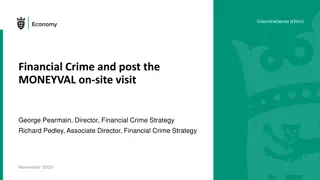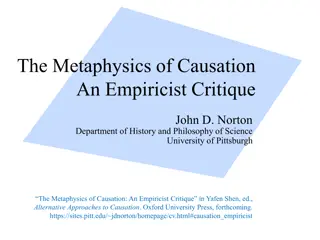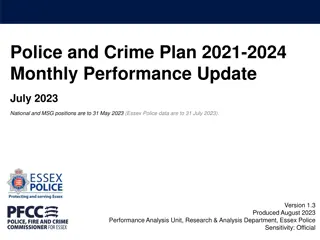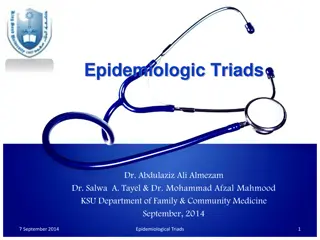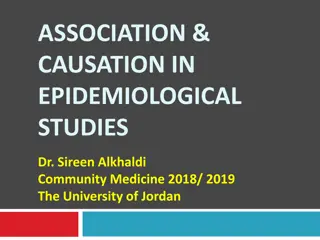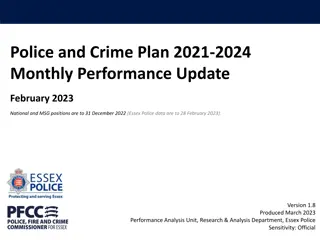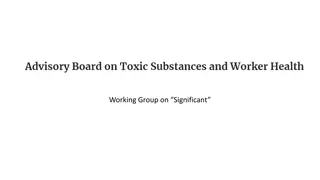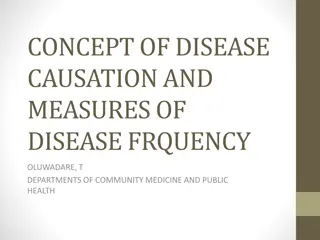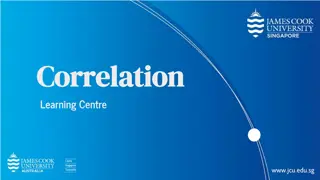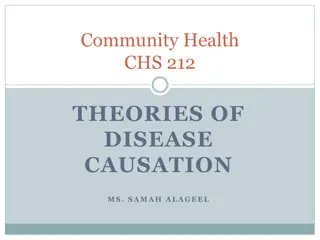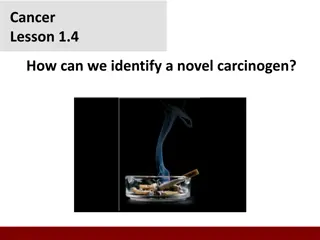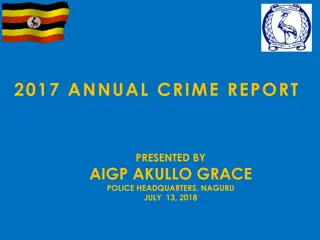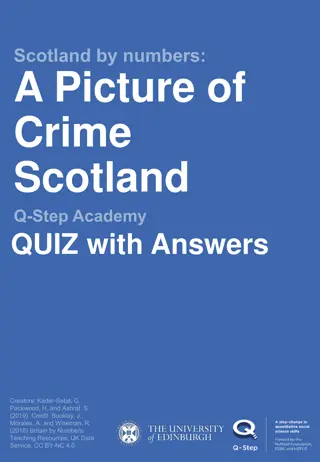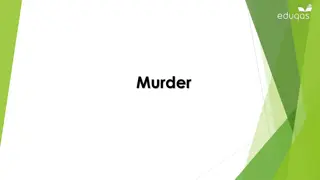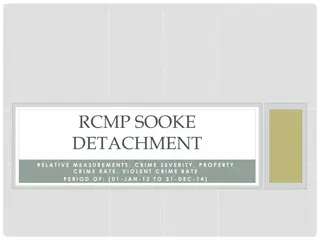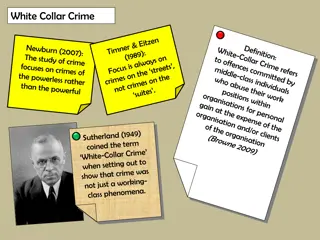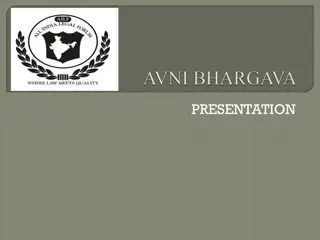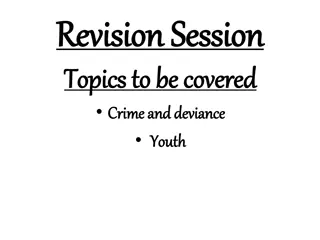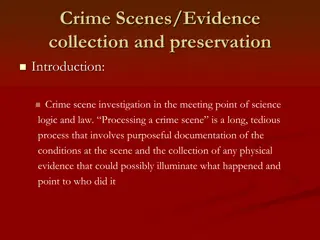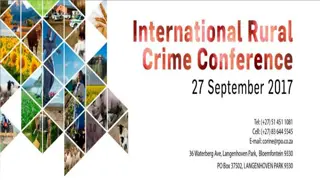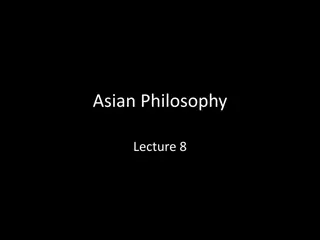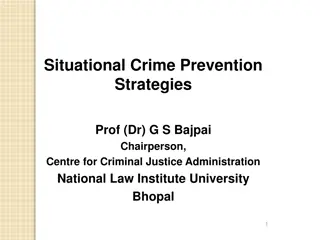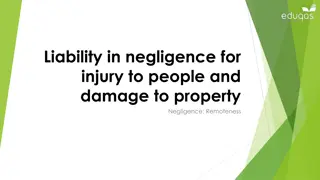The Influence of Media on Public Perception of Crime in Criminal Justice
Influence of the media on public opinion in criminal justice is significant. Media constructs crime narratives, shaping how people perceive causes of crime. Programs like CSI influence juror expectations on evidence, potentially affecting trial outcomes. The evolution towards ethics in journalism un
2 views • 27 slides
Financial Crime - MONEYVAL On-Site Visit November 2023
In November 2023, George Pearmain, Director, Financial Crime Strategy, and Richard Pedley, Associate Director, Financial Crime Strategy, are involved in preparing for the MONEYVAL on-site visit to address financial crime matters.
2 views • 8 slides
Critique of Causal Metaphysics and Empiricism
In this content, the author critiques the metaphysics of causation from an empiricist perspective, exploring the limitations of empiricism in understanding the contingent truths of the world. It discusses causal antifundamentalism, various forms of skepticism, including Humean skepticism, and challe
4 views • 55 slides
Exploring the Implementation of CPTED Strategies in Crime Prevention
Understanding CPTED (Crime Prevention Through Environmental Design) and its application is crucial for reducing crime and improving quality of life. This approach involves designing and using the built environment effectively to create safer communities. The delivery of CPTED involves collaboration
6 views • 21 slides
United Nations Survey on Crime Trends and Operations of Criminal Justice Systems
The United Nations Survey on Crime Trends and Operations of Criminal Justice Systems (UN-CTS) focuses on harmonizing data collection, identifying crime patterns, improving monitoring of the criminal justice system, and enhancing international comparability of crime statistics. It was mandated by the
3 views • 18 slides
CSI Unit Final Project: Mini Crime Scene Challenge
Create a mini crime scene using what you've learned during the CSI unit to challenge your classmates. Your team will have four class periods to complete the project, including a case briefing, the crime scene setup, evidence collection, and a case summary. Remember to include descriptions of the cri
0 views • 12 slides
Essex Police and Crime Plan 2021-2024 Monthly Performance Update July 2023
The Police and Crime Plan 2021-2024 introduced measures focusing on targeted prevention and early intervention by Essex Police. Key priorities were assessed, with grades ranging from Good to Requires Improvement. Confidence in local police showed a decrease compared to the previous year but was high
1 views • 46 slides
Election Manifesto Briefing: Key Takeaways on Tax, Finance, and Crime Policies
Labour, Liberal Democrats, and Conservatives present contrasting plans on tax, finance, and crime policies in their election manifestos. From scrapping business rates to increasing workers' rights and tackling crime, each party has distinct priorities and proposals. The Liberal Democrats focus on ta
0 views • 10 slides
Understanding Epidemiologic Triads in Disease Causation
Epidemiologic triads are essential models for studying disease causation, with a focus on descriptive and analytical epidemiology. By exploring factors such as person, place, time, agent, host, and environment, researchers can identify key relationships in the spread and prevention of diseases. The
2 views • 24 slides
Understanding Association and Causation in Epidemiological Studies
Exploring the concepts of association and causation in epidemiological studies, this content delves into the complexities of determining if exposure leads to disease risk. It discusses different types of associations, such as spurious, indirect, and direct causal associations, illustrating the chall
5 views • 43 slides
Performance Update of Essex Police and Crime Plan 2021-2024 for February 2023
The February 2023 update of the Police and Crime Plan 2021-2024 for Essex Police highlights various aspects of their performance, including grades for different priorities, confidence ratings, crime statistics, and efforts to maintain Crime Data Accuracy. Despite some areas requiring improvement, th
0 views • 37 slides
Understanding the Significance of Exposure in EEOICPA Procedures
Delve into the complexities of exposure assessment in the context of EEOICPA procedures, examining the nuances of significant exposure levels and their impact on causation determination. Explore proposed recommendations for refining exposure assessment metrics to enhance causation evaluation.
0 views • 9 slides
Understanding Disease Causation and Frequency Measures
The concept of disease causation delves into the factors that play a role in the development of diseases, emphasizing the importance of studying causation for prevention, control, and treatment. To infer causation, certain conditions must be met, and a causal relationship is characterized by associa
0 views • 47 slides
Understanding Correlation and Causation in Data Analysis
A correlation analysis assesses the relationship strength and direction between two variables using the Pearson correlation coefficient. It's crucial to differentiate between correlation and causation, where correlation indicates a relationship but not causation. Exploring examples like ice cream sa
0 views • 13 slides
Theories of Disease Causation and Historical Perspectives
Explore the evolution of disease causation theories from miasma theory to germ theory, epidemiological models, and the socio-environmental approach. Understand the definition of disease, its causes, and how ancient beliefs in spiritual or mechanical forces led to new scientific interpretations.
0 views • 30 slides
Understanding Hate Crime and Bullying in Schools
Hate crime is legally recognized and can affect anyone, including children and adults. It is motivated by prejudice or hostility towards five protected groups. Hate crime can manifest through various forms such as physical assaults, verbal attacks, and online hate. Schools often address hate bullyin
3 views • 8 slides
Understanding Crime: Analyzing Bahrain's Safety and Causes
Explore the safety and security status of Bahrain based on indicators like organized crime and police reliability. Learn how science contributes to crime-solving. Delve into the causes of crime in different parts of the world through academic studies and social factors.
1 views • 26 slides
Understanding Carcinogens and Causation in Cancer Research
Exploring the identification of novel carcinogens and proving causation in cancer research through examples like the Ames test, Koch's postulates, and distinguishing between causation and correlation. The challenges in attributing cancer causation and the importance of conclusive evidence for behavi
1 views • 16 slides
2017 Annual Crime Report Highlights and Trends in Uganda
Detailed analysis of the 2017 annual crime report in Uganda presented by AIGP Akullo Grace, covering various aspects including crime comparison, performance metrics, highest reported crimes, and crime trends. The report outlines an increase in reported cases compared to 2016, with insights into spec
0 views • 23 slides
Theories of Causation in Psychological and Social Sciences
Overview of theories of causation categorized into psychological, social psychological, and sociological perspectives. Psychological theories focus on instinctive, biological, and psychological qualities of abusers, including Attachment Theory, Psychodynamic Theory, Social Learning Theory, and Situa
0 views • 15 slides
Exploring Gender Disparities in Crime
Delve into the intricate relationship between crime and gender by examining key sociological concepts like social control, chivalry thesis, and gender socialization. Understand why men are more inclined towards drug use compared to women. Explore questions on historical crime trends and the increasi
0 views • 16 slides
Essex Police and Crime Plan 2016-2020 Performance Update November 2019
The November 2019 update on Essex Police's performance under the Police and Crime Plan 2016-2020 reveals a 13.6% increase in all crime for the period to November 2019 compared to the previous year. While some improvements have been made in various priorities, concerns persist in areas such as local
1 views • 15 slides
Understanding Professional Duties in Accountancy
This informative content discusses various aspects of professional duties in accountancy, such as negligence, breach of duty of care, causation, asset valuation, and ethics. It covers topics like duty of care, foreseeability test, breach of duty standards, causation principles, and the accountants'
1 views • 10 slides
The Grim Reaper Paradox: A Metaphysical Inquiry into Time and Causation
Exploring the intriguing Grim Reaper paradox and its implications on the necessity of finitude in time and causation, this content delves into various philosophical arguments surrounding the concept of infinity and the nature of existence. Through detailed analyses of different paradoxes and argumen
0 views • 33 slides
Crime in Scotland Quiz: Test Your Knowledge about Crime Statistics
Explore a engaging quiz featuring questions related to crime in Scotland, covering topics such as surveys, crime rates, property crime, violent crime, police views, public perceptions, and more. From the Edinburgh Study of Youth Transitions & Crime to data on adults' experiences and perceptions, thi
2 views • 4 slides
Understanding Murder in Common Law
Murder, as defined in common law, is the unlawful killing of a human being with malice aforethought. This act involves both actus reus (unlawful killing caused by the defendant) and mens rea (intention to kill or cause grievous bodily harm). Legal causation, including thin skull test, chain of causa
0 views • 18 slides
Transitioning to Incident-Based Crime Reporting: Enhancing Transparency and Accountability
Anytown Police Department (APD) is leading the transition from Summary Reporting to Incident-Based Reporting through the National Incident-Based Reporting System (NIBRS). This change promotes transparency, provides detailed crime data to the public, and improves statewide and national crime statisti
3 views • 17 slides
Crime Statistics and Severity Analysis: RCMP Sooke Detachment
An overview of crime severity measurements, property crime rates, and violent crime rates in Sooke and comparable detachments. The data includes crime severity index scores, crime type contributions by year, and property/violent crime rates per 1000 population. The analysis shows changes over time,
0 views • 8 slides
Understanding White Collar Crime and Occupational Crime
White collar crime encompasses various offenses such as fraud, embezzlement, forgery, collusion, and tax evasion. This type of crime can often go undetected due to its complex nature and the difficulty in investigating it. Occupational crime, on the other hand, involves employees stealing from their
0 views • 7 slides
Understanding White Collar Crime: Impact on Society
White-collar crime, rooted in the elite's professional roles, has seen a rise in recent years, often linked to large corporations. Edwin Sutherland defined this type of crime, highlighting the intelligence behind its execution and the significant economic losses incurred. Contrasted with blue-collar
0 views • 16 slides
Understanding Crime and Deviance: Control, Solutions, and Measurement
Exploring the concepts of crime and deviance, this content delves into various aspects such as types of deviance, agents of social control, solutions to crime, the penal system, methods of punishment, and measurement of crime through victim surveys and self-reported studies. It highlights the comple
0 views • 43 slides
Crime Scenes and Evidence Collection: The Intersection of Science, Logic, and Law
Crime scene investigation is a meticulous process that involves documenting the scene conditions and collecting physical evidence to unravel the truth behind a crime. Understanding what constitutes a crime scene, the importance of evidence, conducting initial surveys, taking precautions, and conduct
0 views • 40 slides
Addressing Rural Crime in Agriculture: Challenges and Solutions
The presentation highlights the global issue of crime in farming communities, discussing manifestations of crime rates, characteristics of farmers in dealing with crime, features of rural environments, and approaches to combating crime. It sheds light on various crimes affecting agriculture such as
0 views • 10 slides
Exploring Sankhya Philosophy: Metaphysical Dualism and Causation
Delve into the ancient Sankhya philosophy, the oldest school of Indian philosophy founded by Kapila. Discover its metaphysical goal of avoiding monistic materialism and idealism, leading to a dualism between nature and spirit. Explore the concepts of Prakriti (Nature) and Purusha (Self), along with
0 views • 38 slides
Exploring Time and Change in Philosophy: Possible Worlds and Causation
Dive into the intriguing concept of time without change in the philosophical discourse presented by Cathy Legg from the University of Waikato. Delve into the Regularity Theory of Causation, examining the close relationship between time and change, challenges to traditional views, and the possibility
0 views • 27 slides
Understanding Situational Crime Prevention Strategies
Situational crime prevention strategies aim to reduce crime by altering environmental conditions, influencing offender decisions, and targeting crime opportunities. Primary prevention focuses on modifying physical and social environments, while secondary prevention aims to identify potential offende
1 views • 31 slides
Understanding Correlation and Causation
Explore the concepts of correlation and causation through various scenarios such as handwashing and sickness, wearing a favorite football jersey and winning games, or memorizing study guides for tests. Distinguish between correlation and causation with thought-provoking examples like ice cream sales
0 views • 14 slides
Psychological Theories of Crime Causation: An Overview
Psychological theories of crime causation explore factors such as psychological development, childhood experiences, socialization, and individual characteristics that contribute to criminal behavior. These theories delve into the influence of mental disorders, personality traits, and psychoanalytic
0 views • 16 slides
Understanding Liability in Negligence: Remoteness and Causation
Explore the concept of legal causation in negligence cases by delving into the tests for establishing remoteness. Dive into landmark cases like Re Polemis & Furness, Withy & Co Ltd. [1921] and Overseas Tankship (UK) Ltd v. Morts Dock and Engineering Co Ltd or (Wagon Mound) (No. 1) [1961] to understa
0 views • 12 slides
Examining Crime Reduction and Enhancing Student Learning Through Community Partnership
This study delves into the partnership between businesses, the community, and educational institutions to tackle crime and disorder in town centers. It emphasizes the importance of combining different data sources to understand and combat prolific offending. The research highlights gaps in current u
0 views • 22 slides

